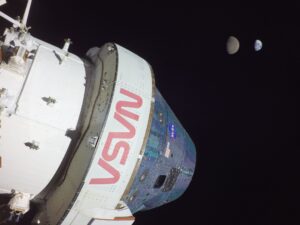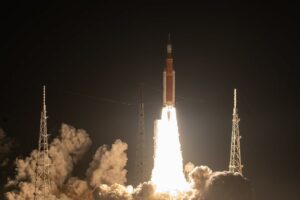HUNTSVILLE — The Space Launch System (SLS) rocket performed with precision, meeting or exceeding all expectations during its debut launch last month on Artemis I, NASA said.
The world’s most powerful rocket sent NASA’s Orion spacecraft on course for a journey beyond the moon and back. The flight lays the foundation for the first mission with astronauts on Artemis II and humanity’s return to the lunar surface beginning with Artemis III.

“The first launch of the Space Launch System rocket was simply eye-watering,” said Mike Sarafin, Artemis mission manager. “While our mission with Orion is still underway and we continue to learn over the course of our flight, the rocket’s systems performed as designed and as expected in every case.”
The twin solid rocket booster motors responsible for producing more than 7 million pounds of thrust at liftoff reached their performance target, helping the rocket and spacecraft travel more than 27 miles from its launch site at Kennedy Space Center and reaching a speed of about 4,000 mph in just over two minutes before the boosters separated. No issues were reported for any of the booster subsystems including its avionics and thrust vector control system used for steering.
Analysis shows the rocket’s core stage and four RS-25 engines, which burned through 735,000 gallons of propellants in just over eight minutes, met every expectation during launch as well as in the final minutes of the countdown.
The mega moon rocket delivered Orion within about three miles of its planned orbit altitude of 975 by 16 nautical miles, well within the planned range required for the mission, at a speed of approximately 17,500 mph.
The interim cryogenic propulsion stage, the upper stage of the rocket used to perform two burns during the mission to first raise Orion’s orbit and then propel it toward the Moon, performed exactly as planned.
The upper stage’s single RL-10 engine, which has powered successful missions to every planet in the solar system and to interstellar space over its more than 50 years in operation, set a single duration burn record, firing for more than 18 minutes to set Orion precisely on its multi-day outbound trek to intercept Earth’s nearest celestial neighbor.
“Performance was off by less than 0.3 percent in all cases across the board,” Sarafin said.
Engineers will conduct more detailed analysis of the SLS performance over the next several months as the agency continues making progress building and assembling elements for the rocket for Artemis II and beyond.

“I’ve been privileged to lead the team which designed, built, tested and now flown the Space Launch System rocket on its historic first flight, the Artemis I mission,” said John Honeycutt, SLS program manager at NASA’s Marshall Space Flight Center in Huntsville, Alabama. “With this amazing Moon rocket, we’ve laid the foundation for Artemis and for our long-term presence at the Moon. The performance of the rocket and the team supporting its maiden voyage was simply outstanding.”
The SLS Program is managed by Marshall, and many parts of the rocket were built and tested at Marshall and at NASA’s Michoud Assembly Facility in New Orleans, as well as at Stennis Space Center in Bay St. Louis, Miss.
Engineers at Marshall supported the Artemis I launch real-time from the center’s SLS Engineering Support Center as well as in the Launch Control Center at the Kennedy Space Center.
Don’t miss out! Subscribe to our email newsletter to have all our smart stories delivered to your inbox.


